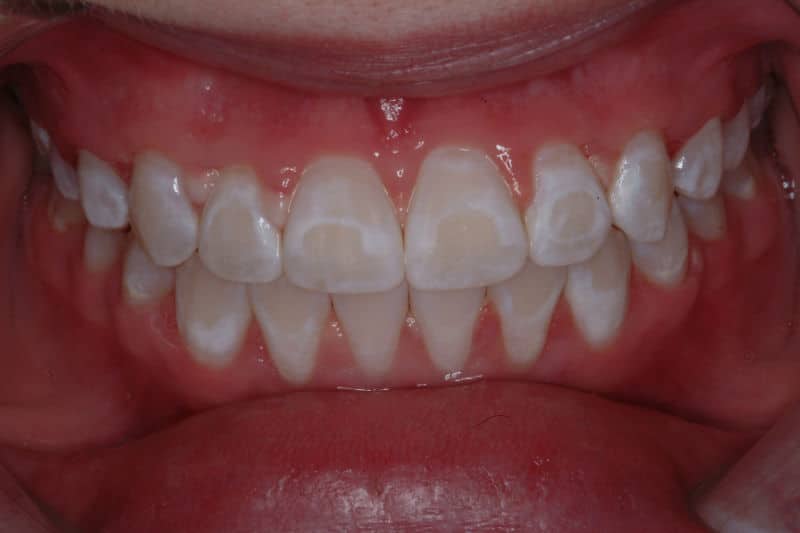WHITE SPOTS APPEAR on our teeth for a variety of reasons. Although not all of them are harmful to our oral health, they still prevent our smiles from truly shining through.
Today we want to share with you some of the most common reasons these white spots appear, and what treatment is available to remove them and give you a bright, beautiful smile.
#1: Fluorosis
One cause for those unsightly white spots is fluorosis, which is what happens to our adult teeth when we get too much fluoride before they finish developing under our gums. Fluorosis doesn’t damage the teeth, it just creates an uneven, sometimes spotty bleaching effect.
The best way to avoid it is to make sure your child isn’t using too much toothpaste when they’re under eight years old. You should only use a dab of toothpaste no larger than a smear or a grain of rice on babies and toddlers.
Beware there are many false facts out there about fluorosis! It is important to know the role of fluoride and how we can maximize its effectiveness without doing any harm. This video below does a great job explaining how to balance the effects fluoride can have good and bad.
#2: Enamel Hypoplasia
Having hypoplastic tooth enamel means having a thinner or less mineralized layer of enamel than usual. Usually, this involves the tooth having pits in it. Because these pits are porous this leaves teeth vulnerable to stains and tooth decay. It can be caused in teeth by a variety of sources such as hypocalcemia, birth injury, fluorosis, infection, chickenpox that was undiagnosed and untreated. This type of discolorization is usually treated with bonding on the teeth until the person becomes an adult at which time dental veneers can become an option.
#3: Demineralization
Another common cause of white spots on teeth, and perhaps the most dangerous one to dental health, is demineralization. When plaque isn’t sufficiently cleaned away, it eats away at the minerals on the surface of our teeth, leading to the loss of enamel and the buildup of tartar. Healthy brushing and flossing habits, as well as regular dental cleanings, are essential for preventing demineralization.
#4: Braces And Demineralization
This is Dr. McOmie’s pet peeve!! There is absolutely NO reason for this and we should NEVER see it. Having braces makes your teeth particularly vulnerable to decalcification. It takes more effort to reach all those tiny crevices where plaque can build up, and any change in the color of your teeth won’t affect the patches beneath the brackets. With braces, therefore, it’s not only important to brush and floss thoroughly to keep plaque and tartar at bay. Braces take a little extra work to keep clean maybe 1 minute extra a day. Really it isn’t that much more work. We place most of our kids with braces on a fluoride rinse because they are going to get some acid attack on their teeth, we want that to be minimized. Dr. McOmie would rather see crooked teeth than demineralized straight teeth. Braces should only be done on people who are committed to doing what it takes to take care of their teeth with the braces on. It is ridiculous to have straight teeth that were damaged by the braces. It makes no sense.
Different Options Exist For Treating White Spots
Preventing white spots is always preferable to needing to treat them after they form, but there are a few treatments available.
- Microabrasion involves carefully removing a thin layer of enamel to give your teeth a more uniform appearance, and sometimes this is paired with tooth-whitening treatments.
- Bleaching is another way of giving your teeth more balanced color. While there are over-the-counter bleaching kits, we recommend having it done in the dentist’s office or with dentist-approved take-home kits.
- Veneers are a good option when the staining is particularly severe and bleaching won’t be enough to fix it. The dentist attaches thin porcelain to your teeth, giving them a natural, white appearance.
- Bonding works really well when we need to cover a small amount of stain or fill in a pit that is attracting stain. If you have lots of stain, severe pitting or are looking for the ultimate cosmetic result then veneers are for you. Bonding works well we use bonding on young adults and children instead of veneers then do veneers when they become adults and their teeth have erupted all the way.
- And more, every person is different and there may be another alternative to what is listed above for you. Come in and let our dentists look at you it probably isn’t as bad as you think it is.
Let’s Keep Those Smiles Sparkling!
If you’re concerned about preventing white spots, brown spots, pits or already have them and would like to discuss treatment, don’t hesitate to schedule an appointment! McOmie Family Dentistry 423-899-1112.




